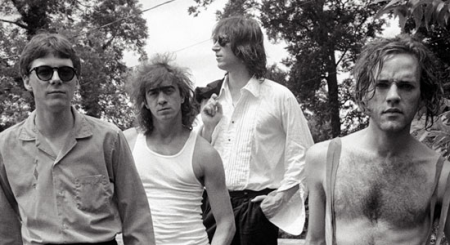1) Finest Worksong; 2) Welcome to the Occupation; 3) Exhuming McCarthy; 4) Disturbance at the Heron House; 5) Strange; 6) It’s the End of the World As We Know It (And I Feel Fine); 7) The One I Love; 8) Fireplace; 9) Lightnin’ Hopkins; 10) King of Birds; 11) Oddfellows Local 151
Upsizing to stadium size, maybe a little too soon. But what a singles run, right?
Key tracks: "Finest Worksong", "It's the End of the World As I Know It (And I Feel Fine)", "The One I Love"
R.E.M. go big. The jump between Life’s Rich Pageant and Document is the largest so far between albums: far from the enthusiastic ramshackle riot of Pageant, Document is super-slick and booming like an American answer to what U2 were doing in the 80s. The production is sharp and gives even the smallest of songs a stadium-like feel, ready to be played for huge crowds. The angles the record covers are similarly big, with R.E.M. becoming more openly political and shaping Document to be a reflection of the political landscape at the time. It’s not quite enough to call Document a deadly serious album but there’s a conscious effort to make it an important one, both topically and as means for the band to reach larger audiences. This is R.E.M. knowingly attempting leap to the big leagues.
That they did. Document features not only the band’s first genuine hit but also their first pop-culturally iconic song. The former is “The One I Love”, a spiteful anti-love song performed like a fiery political fist-pumper: a song that sounds vulnerable in its verses yet rises into a furious chorus designed to soar, Stipe belting out like he’s never done before. The latter is “It’s the End of the World as We Know It (And I Feel Fine)”, a wild machine-gun rollercoaster with a ridiculously charming levity and an incredible array of hooks, including so many individual seconds in Stipe’s rapid fire stream of consciousness and the countless different backing vocal lines carrying each other. Both songs are famous enough that they don’t need any further introduction or description, but both are bonafide classics for a reason - “It’s the End of the World” especially so, which will never fail to throw a flurry of excitement whenever it plays, leading into impromptu singalongs wherever it goes: it’s a joyously perfect song. The third single off the album, “Finest Worksong”, doesn’t quite share the immortality of the other two but it’s where the R.E.M.’s ambitions for Document show up the clearest. It’s a huge song, meant to be played ridiculously loud and turned into an anthem. It only suffers in comparison to the other two songs, but on its own it’s a stormer, with Mills’ backing vocals once again stealing the spotlight in the chorus. There are very few songs in the R.E.M. catalogue as colossal as this in terms of sheer weight of the music.

The second half of Document makes a conscious move away from the straightforward rock songs and this is a blessing for the album, because it revives Document’s mojo. “Fireplace” and “Lightnin’ Hopkins” in particular are more in line with what “Finest Worksong” promised all the way in the beginning: almost-anthems with a fire in their belly and a commanding charisma. “Fireplace” sways and tilts with its rhythm alluringly before breaking down into an extended instrumental section starring a sax going crazy: it’s an unexpected swerve not just in the song, but on the entire album and it makes the song stand up even more, if the already interesting first half of the song didn’t do it already. “Lightnin’ Hopkins” meanwhile goes hard - it’s very atypically muscular and beefy for R.E.M. and arguably one of their most outwardly aggressive songs. It’s a rush of power and this time the hit lands. It’s excellent and exhilirating and stands up among the album’s best songs. “King of Birds” is a slight retread of Reckoning’s “Time After Time”, with a similar march-like beat and a dulcimer part that echoes the vaguely sitar-like guitar lines of “Time After Time”. There are worse songs to make a spiritual sequel for, and even if it’s not the most exciting of the cuts here it still has flashes of brilliance to it.
That leaves us with “Oddfellows Local 151”, a somewhat overlong slog of a song that never picks up into anything particularly interesting even if tries to reach for that moody closer spot, which closes off Document in a mildly disappointing manner. It suits Document in that regard: the album aims high and promises a lot (especially if you’ve only ever heard the two classics off it) but it doesn’t quite reach its goals. R.E.M. wanted to prove they can hit it big time while taking advantage of that in order to get the messages they wanted to send out heard, but if anything it proves that purposefully aiming for that scope doesn’t come naturally for R.E.M. They became a stadium band eventually but not through the kind of stadium rock sound they tried to go for here, and R.E.M.’s attempts at it vary greatly. Document is a good album but it’s also one where you can see the cracks more clearly than in a lot of other R.E.M. albums: in an attempt to scale up deliberately, they only managed to muddle up their own sound. And let’s face it - without its three solid classics, it would definitely be rated a notch lower.

No comments:
Post a Comment